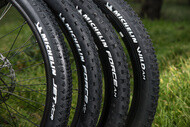Storing your tyres (mounted or dismounted) may sometimes be necessary. What special precautions should you take for bike tyre storage to preserve them as much as possible? Should tyres be stored differently depending on whether they are tubeless, tubed or tubular? You'll find out all you need to know after reading our experts' recommendations in this article.
How to store tyres?
Let's start with a few general recommendations.
For good preservation, bicycle tyres should be stored in a dry place, away from UV rays. Temperatures are also an important criterion, because at their extremes they have a damaging effect on tyres. When it's too cold (below 0°C, for example), the tyre rubber can break. When it's too hot, the tyre's ageing process accelerates. Tyres should therefore be stored at a moderate temperature.
Avoid air-conditioned areas as some air-conditioners generate ozone, which can damage the chemical compounds in tyres.
We also recommend that you never store bike tyres in spaces where electrical equipment, solvents, hydrocarbons, fuels or chemical products are present.
How to store Tubeless Ready tyres?
If you are planning to go on holiday for a long period, we recommend that you remove your Tubeless Ready tyres and also the sealant inside. If you've only been using this fluid for a short time, you can store it in a closed container to prevent it coming into prolonged contact with the air.
Why is it important to remove the tyre before storage?
Because if the tyre remains mounted and static for a long period of time, the fluid will accumulate at the bottom of the tyre. And as the tyre gradually loses its pressure, it will deflate at the very point where the fluid has settled, allowing air to enter. On contact with the air, the liquid will harden... if it hasn't already spilled outside the tyre!
If the liquid has coagulated, it will obviously no longer be able to seal the tyre.

If you're coming back after a long period and hadn't thought to take the precautionary steps mentioned above, we recommend that you take a bead out of the tyre and check the state of your sealant before setting off on your bike. If the fluid is still in the tyre, simply replace the bead, reinflate and ride. If the fluid has already coagulated, remove all the residue (you can do this quite easily by scraping with a fingernail). Then reinject new sealant.
How to store tyres with inner tubes (Tubetype)
If they are fitted, avoid leaving them like this for too long. Over time, they will deflate and the weight of the bike will eventually create small cracks. If you can't dismantle the wheels and hang them up, the best thing to do is to turn your bike over.
Should Tubetype tyres be folded before storage?
When storing Tubetype tyres, make sure you fold them as they were in their original packaging. A tyre with a soft bead that has been demounted can be folded, but you should never fold tyres with a rigid bead.
If you have bought tyres that were originally folded, there is no need to keep them unfolded for storage. If you know you won't be using them straight away, you can fold them without any problem. However, if the tyre is still in its original packaging, there is no reason to take it out.
How to store Tubular tyres?
Tubular tyres should be stored in the same way as rigid beaded tyres. Do not fold them and hang them up in a dry place away from light.
We'd like to take this opportunity to remind you of a few precautions to take with tubular tyres before you ride them for the first time. Tubular tyres are not manufactured in the same way as Tubetype tyres: since solvents are applied at the factory, it's important to let them evaporate before the first use: before rolling, inflate your tyre (not necessarily to maximum pressure) so as to stretch the casings and leave it for 24 hours. This time is necessary for the solvents to evaporate completely.
How long can you keep tyres?
There is no correlation between the age of a tyre and its ageing. The ageing of a tyre depends exclusively on the conditions in which it has been stored and the way in which it has been used. For example, a new tyre parked or stored next to a transformer can show, in just a few days, irreversible sidewall damage (cracking), which will affect its performance and pressure resistance. So be sure to follow our advice to preserve your stored tyres for as long as possible!



